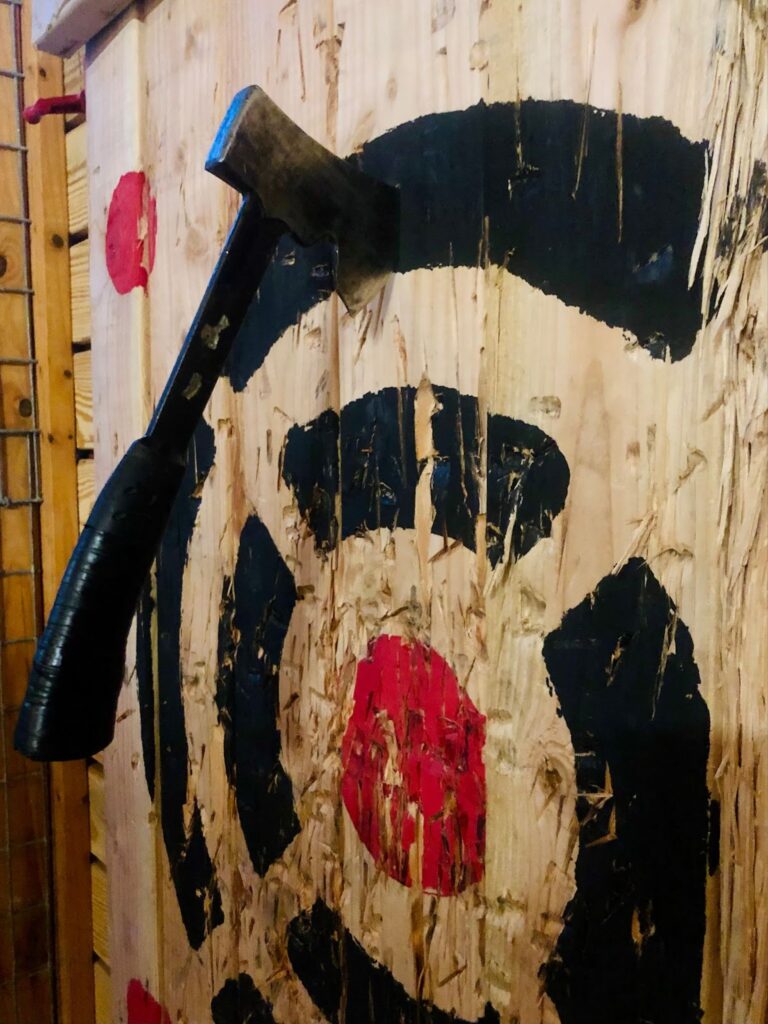Axe-throwing has evolved from its humble origins as a lumberjack pastime to a thrilling recreational activity enjoyed by enthusiasts worldwide. Central to mastering this exhilarating sport is selecting the right axe.
However, with a plethora of options available, choosing the perfect axe for throwing can be a daunting task. In this comprehensive guide, we’ll delve into the key factors to consider when selecting an axe, from design and weight to materials and handle grip. Whether you’re a seasoned pro or a curious newcomer, this article will equip you with the knowledge to unlock precision and elevate your axe-throwing experience.

Understanding Axe Anatomy
Before diving into the selection process, it’s essential to understand the anatomy of an axe and how each component contributes to its performance:
Head
The head of an axe consists of the blade, which is the cutting edge, and the pole, which is the opposite end used for striking or pounding. When choosing an axe for throwing, focus on the blade’s shape and size, as it directly impacts the axe’s flight and penetration upon impact.
Handle
The handle, also known as the haft, provides leverage and control during throwing. It’s crucial to consider the length, material, and grip of the handle when selecting an axe, as these factors influence comfort, balance, and accuracy.
Weight Distribution
The distribution of weight between the head and the handle affects the axe’s balance and trajectory when thrown. Axes with a balanced weight distribution are generally easier to control and yield more consistent results.
Key Considerations When Choosing an Axe for Throwing
Axe Design and Shape
The design and shape of the axe head play a significant role in its performance for throwing. Opt for a single-bit axe with a symmetrical blade profile, as it ensures uniform weight distribution and predictable flight characteristics. Avoid double-bit axes or axes with irregular blade shapes, as they can compromise accuracy and consistency.
Blade Profile and Sharpness
Choose an axe with a narrow blade profile and a sharp cutting edge, as it enhances penetration and minimizes deflection upon impact. Avoid axes with overly thick or blunt blades, as they may struggle to stick to the target and increase the risk of bounce-backs or rebounds.
Axe Weight
The weight of the axe significantly influences its throwing dynamics and user fatigue. Select an axe with a moderate weight ranging from 1.5 to 3 pounds, as it strikes a balance between momentum and maneuverability. Avoid excessively heavy axes, as they can be difficult to control and lead to muscle strain or fatigue during extended throwing sessions.
Handle Length and Material
Consider the length and material of the axe handle based on your throwing technique and personal preferences. Opt for a handle length between 12 to 16 inches, as it provides sufficient leverage without sacrificing control or accuracy. Additionally, choose a handle made from durable hardwood, such as hickory or ash, as it offers resilience against impact and provides a comfortable grip.
Handle Grip and Texture
Pay attention to the grip and texture of the axe handle, as it influences control and stability during throwing. Look for handles with a smooth finish and ergonomic contours that fit comfortably in your hand. Avoid handles with excessive lacquer or varnish, as they can become slippery when exposed to moisture or sweat.

Balance and Weight Distribution
Test the balance and weight distribution of the axe by holding it at various points along the handle. A well-balanced axe should feel comfortable and stable in your hand, with neither end significantly heavier than the other. Avoid axes with uneven weight distribution or excessive top-heaviness, as they can adversely affect throwing accuracy and control.
Quality and Craftsmanship
Invest in a high-quality axe crafted from premium materials and precision-engineered for performance and durability. Choose reputable brands known for their expertise in axe manufacturing and commitment to craftsmanship. Avoid cheaply-made axes with inferior materials or construction, as they may compromise safety and longevity.
Throwing Style Compatibility
Consider your throwing style and technique when selecting an axe. Different throwing styles, such as overhead, sidearm, or two-handed, require axes with specific characteristics to optimize performance.
For example, if you prefer an overhead throw, choose an axe with a longer handle for increased leverage and accuracy. Experiment with different axes to find one that complements your throwing style and feels natural in your hand.
Target Material and Compatibility
Assess the type of target you’ll be throwing at and choose an axe that’s compatible with it. Traditional wooden targets require axes with sharp blades and sufficient weight to penetrate the wood effectively. If you’ll be throwing at foam or rubber targets, consider axes with blunter blades to prevent damage to the target surface.
Additionally, verify that the axe’s dimensions and weight are suitable for the target’s size and distance, ensuring optimal performance and safety during throwing sessions.
Personalization and Customization Options
Explore opportunities for personalization and customization when selecting an axe for throwing. Many manufacturers offer customization options, such as engraved handles, custom paint finishes, or personalized grip tape, allowing you to tailor the axe to your preferences and style. Additionally, consider accessories such as axe sheaths or carrying cases to protect your investment and enhance convenience when transporting or storing the axe between sessions.
Durability and Maintenance
Prioritize axes constructed from high-quality materials and designed for long-term durability and performance. Choose axes with forged steel heads and hardwood handles, as they offer superior strength and resilience against wear and tear.
Additionally, familiarize yourself with proper axe maintenance practices, such as regular sharpening, oiling, and handle inspection, to prolong the axe’s lifespan and ensure optimal performance over time. Investing in a durable and well-maintained axe will provide years of enjoyment and reliability on the throwing range.
Reviews and Recommendations
Research customer reviews and seek recommendations from fellow axe-throwing enthusiasts or instructors when selecting an axe. Reading firsthand experiences and testimonials can provide valuable insights into the performance, durability, and overall satisfaction of different axe models and brands.
Online Forums
Additionally, consult reputable online forums, social media groups, or local axe-throwing communities for advice and recommendations from seasoned practitioners. By leveraging the collective wisdom of the axe-throwing community, you can make an informed decision and choose an axe that meets your needs and expectations.
Selecting the Right Axe Is Crucial
Selecting the perfect axe for throwing is a crucial step towards mastering this exhilarating sport and unlocking precision in every throw. By considering factors such as design, weight, handle grip, and balance, you can find an axe that suits your throwing style and maximizes your performance on the throwing range.
Whether you’re a competitive athlete, casual enthusiast, or outdoor adventurer, investing in a quality axe tailored to your needs will enhance your enjoyment and success in axe-throwing. So heed the advice outlined in this guide, embark on your quest for the perfect axe, and prepare to unleash your inner lumberjack with every throw.
Check out our Propel Axe blog for the latest on axe-throwing!


 720-330-9755
720-330-9755
